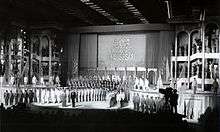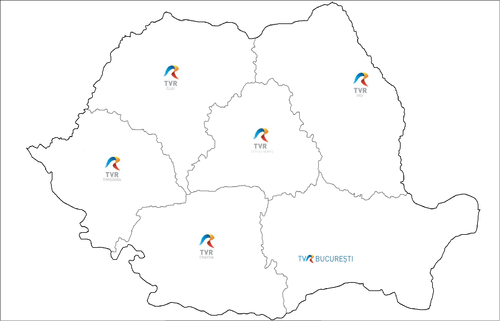Romanian Television
Televiziunea Română (Romanian pronunciation: [televiziˈune̯a roˈmɨnə]),[1] more commonly referred to as TVR [teveˈre], is the short name for Societatea Românǎ de Televiziune (Romanian Television Corporation), or SRTV—Romanian public television. It operates five channels: TVR1, TVR2, TVR3, TVRi, and TVR Moldova along with six regional studios in Bucharest, Cluj-Napoca, Iași, Timișoara, Craiova and Târgu Mureș.
| Type | Broadcast television network |
|---|---|
| Country | |
| Availability | International |
| Motto | "Imaginea timpului tău" ("The Image of your times") |
| Owner | Romanian State (The Government of Romania) |
Key people | Doina Gradea, President and General Chairman since September 2017 |
Launch date | 31 December 1956 |
Former names | Radioteleviziunea Românǎ (1956-1990; when it was the only radio-tv company in the country) |
Official website | www.tvr.ro |
TVR1 has a total national coverage of 99.8% and TVR2 has 91% coverage—all of the other channels and networks cover only densely populated areas. Even though it does not have the largest audience (Pro TV and Antena 1, two private networks, consistently get higher ratings in the urban market segment), it offers a wider variety of services, including webcasts and international viewing.
Starting November 2019, the two main channels, TVR 1 and TVR 2 broadcast fully in HD.
History
Beginnings
TVR was established in 1956, in Bucharest and had its first broadcast on 31 December from a little building (a deserted cinema studio) on Molière Street no. 2.
During the Ceaușescu era
TVR moved in 1969 to a new building, the specially built television center on Dorobanților Avenue. It was designed by well-known architect Tiberiu Ricci.
A second channel, TVR2, was created in 1968 (at that time it was simply called "Programul 2", the second channel and the old TVR became the first channel, "Programul 1"). TVR2 was suspended from 1985, due to the "energy saving programme" initiated by Nicolae Ceaușescu and TVR1 became TVR again, becoming the sole television station in Romania until the fall of communism in 1989.
From 1966 to 1980, TVR had an open program policy. Many films, serials, cartoons and other programs from the US and Western Europe were broadcast on the two main channels.[2]
In 1983, TVR introduced color television. Although the rest of the Eastern Bloc countries adopted the Soviet-backed SECAM system, TVR chose to implement the PAL system. Plans to introduce color television broadcasting date as far back as 1968, when the TVR trialed color technology. It was, however, deemed too costly at the time to impose color broadcasting, and plans were shelved up to 1983. Even so, by 1990, only some broadcasts were in color and only few people owned a color TV set.

Due to the same "energy saving programme" between 1985 and 1989, the TVR schedule was severely limited to only about two hours per day, between 20:00 and 22:00, most of which were dedicated to the cult of personalities of Nicolae Ceaușescu and his wife Elena; with an exception on Saturdays, from 13:00 to 15:00 and 19:00 to 22:30 and Sundays (the same program as Saturdays, but with children's programs between 11:30 and 12:30). The two hours of programming were half propaganda and half general entertainment:
- 19:53 The Socialist Republic of Romania National Anthem ("Trei culori")
- 19:57 The Frontul Democrației și Unității Socialiste ("Democracy and Socialist Unity Front", FDUS) Anthem ("E scris pe tricolor Unire")
- 19:59:30 Opening (clock)
- 20:00 News ("Telejurnal")
- 20:20 Special programs dedicated to Ceaușescu (documentary or musical shows)
- 21:00 An episode of theatre play, opera or a movie[3]
- 21:50 News ("Telejurnal")
- 21:58 Closing ("Hora Unirii")TVR headquarter Bucharest
In 1988 the programs increased to three hours per day during weekdays (from 19:00 to 22:00).[4] The US TV series Dallas, introduced in the mid 1980s, became the only Western television program to be aired on the channel in color.
After December 1989
During the Revolution of December 1989, TVR was an important focal point of the events. Rebels occupied the TVR building, in the afternoon of 22 December and announced that the Ceaușescus had fled. TVR changed its name to "Televiziunea Română Liberă" (TVRL), "Free Romanian Television". On 17 February 1990, TVR2 resumed broadcasting and TVRL became TVR1.
But TVR would remain a propaganda instrument in the hands of the newly created National Salvation Front (FSN), made up mostly of former second-rank Communists. FSN used TVRL, by far the most widely penetrating information source at that time in Romania, to discredit protesters who were demanding a Communist-free government, denigrating them as "fascists". This culminated with the June 1990 riots in central Bucharest, crushed by the miners called in by president Ion Iliescu. After the riots ended, Iliescu was shown on TV congratulating the miners for "restoring law and order". A little while later, following protests from civil society, TVRL abandoned the "L", the designation "Free" and reverted to its previous name of TVR.
After 1990, lacking any strategy, TVR fell into a deep crisis of identity. TVR changed its identity several times without any particular reason. The crisis intensified after 1996.
On 1 January 1993, TVR, as a part of Radioteleviziunea Româna (RTVR), was admitted as a full active member of the European Broadcasting Union, simultaneously with the merger of OIRT and EBU.
In 1995, TVRi was launched on 1 December, Great Union Day, the national holiday. In 1998, TVR International was renamed "TV Romania International", with a completely different identity.
In 2001, TVR2 changed its identity, logo and presentation for the fourth time. The same year, after three "rebrandings", TVR1 became "TV Romania 1". The new "Romania 1" changed its identity, including the channel logo, three times in only two years.
In 2002, TVR Cultural was launched.

In 2003, the management started a controversial rebranding (a new identity was created by the British agency, English & Pockett). On 11 June 2004, all channels were renamed "TVR" and received the same identity.
On 2 December 2006, Romania hosted the international Junior Eurovision Song Contest. The Romanian broadcaster was chosen by the European Broadcasting Union (EBU) to become the organizer of the 4th edition of the contest.
In October 2007, during its prime-time newscast, TVR aired a video showing Agriculture Minister Decebal Traian Remeş allegedly taking a bribe. In the aftermath, Prime Minister Călin Popescu-Tăriceanu criticised TVR for carrying out the minister's "public execution", and a heated debate that showed TVR's weakness in defending its independence ensued. The station's own director called the airing incorrect and illegal because it violated the presumption of innocence, while media organisations and the broadcast regulator defended the legitimacy of the airing, which they said served the public interest. Politicians issued intense attacks against TVR, which reorganised its news department into two divisions. One of its most critical journalists, Rodica Culcer, was placed in charge of supervising both divisions, which actually reduced her decision-making; reassignment has been a typical way through which Romanian governments reduce the power of non-loyal individuals, as more overt measures may have attracted charges of censorship. Other independent journalists were moved to afternoon or night newscasts.[5]
In August 2008, TVR acquired the broadcasting rights for the UEFA Champions League in Romania, for the following three seasons (between the 2009–10 and the 2011–12 season).[6] From the 2012–13 season, it has the second option for the broadcasting rights.[7]
On 1 June 2008, TVR HD started broadcasting in HD. The Euro 2008 and the 2008 Summer Olympics were transmitted in HD.
On 10 October 2008, TVR 3 was launched. This is a channel dedicated to local programming, airing shows and news produced in the various regions of Romania.
On 31 December 2008, TVR Info, a "must-carry" channel for all cable operators, was launched. The channel broadcasts traffic information, live feeds from cameras in various cities of Romania, and news.
On 19 April 2016, it was reported that Romania's participation in the Eurovision Song Contest 2016 was in danger owing to TVR's repeated non-payment to the EBU of debts totaling CHF 16 million (€14.56 million, US$16.4 million) and dating back to January 2007.[8] The EBU had issued a deadline to the Romanian government requiring it to make satisfactory arrangements to repay the debt by 20 April, or else face exclusion from the contest. Two days later it announced that, following the government's failure to meet the deadline, the EBU had withdrawn all member services from TVR: these included – in addition to TVR's participation in the Song Contest – access to the Eurovision News and Sports News Exchanges, the right to broadcast specific sporting events, and entitlement to benefit from the EBU's legal, technical, research, expertise, and lobbying services.[9][10][11]
Structure
TVR has four national TV channels: TVR1, TVR2, TVR3 & TVRi. TVRi is designed for the Romanians living abroad, the "i" coming from International (Internațional in Romanian). Due to the financial crisis in which TVR is immersed, TVR Cultural and TVR Info closed in the summer of 2012, however the latter was replaced by TVR News three months later. Nevertheless, on 21 July 2015 the TVR board decided to shut down also the TVR News channel, which stopped broadcasting on 1 August 2015.[12] It also has six regional TV channels or "studios" ("studiouri teritoriale"): TVR București, TVR Cluj, TVR Craiova, TVR Iași, TVR Târgu Mureș and TVR Timișoara. TVR HD was available form 2008 to 2019 when it was closed due to TVR 1 & TVR 2 having HD broadcasts.
TVR Moldova broadcasts in Moldova from the local Chișinău studio.
Funding and accusations
Until 2017 TVR was funded by a television licence tax mandatory for all holders of TV sets and also from advertising. This has been deemed unfair competition by the commercial TV stations, which must rely exclusively on revenue from advertisement and cable operators. After removing the 6,5 lei tax, TVR is mainly funded directly by the government.
TVR's board is appointed by the Government and the Parliament. In its post-Communist history, TVR has been almost constantly suspected of submitting to government control and censorship.
References
- "Arheologie Radio📻Tv📺". Tvarheolog.wordpress.com. Retrieved 23 August 2019.
- "10 Octombrie 1987". Tvarheolog.wordpress.com. Retrieved 23 August 2019.
- "TVR 60 - ISTORIA ÎN ŞTIRI Două ore de program TV pe zi. "Serialul Bezna" (TVR 60 - HISTORY THROUGH NEWSCASTS. Two hours of TV per day. The "Darkness" series)" (in Romanian). 2 November 2016. Retrieved 15 December 2018.
- Pippa Norris, Public Sentinel: News Media & Governance Reform, p.269-70. World Bank Publications, 2010. ISBN 0-8213-8200-4.
- "TVR va transmite Champions League, Pro TV ramane fara fotbal! - Fotbal - HotNews.ro". Sport.hotnews.ro. 1 April 2008. Retrieved 23 August 2019.
- "REALITATEA". Realitatea.net. Retrieved 23 August 2019.
- "Romania's Eurovision dream buried by mounting debt". ABC News. 19 April 2016. Retrieved 19 April 2016.
- Jiandani, Sanjay (22 April 2016). "Romania: TVR will not participate in Eurovision 2016". Esctoday.com. Retrieved 22 April 2016.
- Royston, Benny (22 April 2016). "Romania expelled from the Eurovision Song Contest". Metro.co.uk. Retrieved 22 April 2016.
- "EBU withdraws member services from Televiziunea Română (TVR) following repeated non-payment of debt". European Broadcasting Union. 22 April 2016. Retrieved 22 April 2016.
- "TVR News şi-a încetat emisia sâmbătă, la ora 00.00" (in Romanian). Mediafax. 1 August 2015. Retrieved 13 May 2016.
External links
| Wikimedia Commons has media related to Societatea Română de Televiziune. |
- TVR official website
- (in Romanian) Six TVR journalists accuse censorship (Ziua, 8 December 2004)